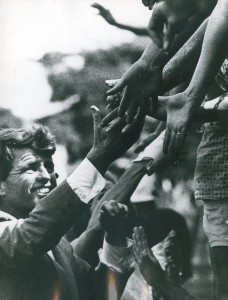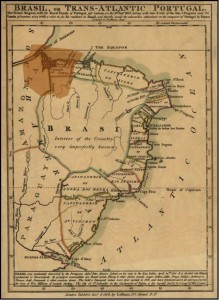This post has kindly been written for us by Courtney J. Campbell, Past & Present Postdoctoral Fellow, @CJCampbell123, courtney.campbell@sas.ac.uk
This year, Brazilians faced a difficult presidential election. Through a preliminary election in October, voters narrowed their choice to two candidates: sitting president Dilma Rousseff of the Workers’ Party or Aécio Neves of the Social Democrat Party of Brazil. While both candidates were born in the city of Belo Horizonte in Brazil’s Southeast, the election was widely discussed in terms of a different region: the Brazilian Northeast. After the preliminary vote, newspapers ran strongly worded editorials critical of the Northeast and its loyalty to the Workers’ Party. Tweeters and Facebookers followed suit, publishing disparaging comments about Northeasterners that referred to them as too ignorant and illiterate to understand who they should vote for or as lazy and simply wanting to remain on the welfare check supported by the Workers’ Party. In some cases, the insults even came in the form of racist comments, referring to the majority mixed-race population of the Northeast. In response, many Northeasterners defended their region on social media, highlighting its contributions to Brazilian literature and culture. A new hashtag gained fame on Twitter – #essesnordestinos – reflecting disparaging and even violent comments that began with the phrase ‘those northeasterners …’ and a Tumblr account was set up to gather negative comments found on social media about the Northeast. In the runoff election, Rousseff did carry the Northeast easily, with nearly 80% of the vote in several states, while Neves was more popular in the Southern and most Southeastern states (though this map is careful to show that in reality, all states are some shade of purple). This social media storm emphasizes the roles that the Brazilian Northeast plays within the nation. The Northeast serves as root of national culture, as scapegoat for the nation’s problems, and as foil to the ideal socially equal and developed Brazil that so many Brazilians hope to achieve.
What is surprising about this Northeastern regional identity is that it formed so quickly. In 1919, the term ‘Northeast’ came into use within governmental reports referring to the drought region. Before that, there were ‘North’ and ‘South’, but no ‘Northeast’. I study how this area originally defined by rainfall morphed into a cultural and social identity. I focus on how Brazilians discussed what it meant to belong to the Northeastern region in the mid-twentieth century and how this cultural identity was both influenced by and influenced the region’s relations with the world around it. I write about moments of intense international action that took place in the Northeast or that involved Northeasterners, including romantic relationships between Brazilian women and U.S. soldiers stationed in the Northeast during World War II, a campaign to bring a World Cup soccer match to the Northeast in 1950, and Miss Universe pageants in which Northeastern women competed in the 1950s and 1960s. My work emphasizes that for ideas about Northeastern culture and the definition of its borders to become popular ideas (popular enough to be readily presented and understood on Twitter and Tumblr) they had to be relevant to a variety of social groups. For this reason, I analyze popular art, including popular music, pamphlet poetry (called cordel), hand-made ceramics, and even liquor labels. I study these popular sources alongside more traditional historical sources, like intellectual manuscripts, film, letters, political agreements, and the press. By analyzing such a wide variety of sources, I explore how ideas about the region and its meaning circulated among social groups and across international lines. In this way, my work emphasizes that what being Northeastern meant was discussed across social classes, depended to a surprising degree on international attention and activity in the region, and came about as much through debate as through agreement.

‘Robert Kennedy in Brazil (Bob Kennedy no Brasil)’, image housed at the Museu da Imagem e do Som in São Paulo.
I currently hold a Past & Present Postdoctoral Fellowship at the IHR, allowing me to spend this academic year converting my doctoral thesis into a book manuscript. As part of this project, I am writing a section that shows that the discussion of Northeastern regional identity was not just words. This section examines President John F. Kennedy’s international aid project, The Alliance for Progress, in the Brazilian Northeast as well as Senator Robert Kennedy’s visit to the region in 1965. This section will establish that how the Northeast was discussed within the region also influenced how it was understood from without. On one hand, discussions about the Brazilian Northeast that circulated among social groups in previous decades influenced how U.S. policymakers viewed the region and imagined it at once as a staging ground for projects aimed at development and as a hotbed of communist agitation before and after the Cuban Revolution. On the other, how the Kennedy administration and later Robert Kennedy discussed the Northeast consolidated certain existing stereotypes on an international scale while excluding others.
I became interested in the Brazilian Northeast, its place within the nation, and its international interactions when I lived, worked, and studied there. I moved to Recife, Pernambuco in 2003 after serving as a Peace Corps volunteer in the Paraguayan Chaco. I left Recife in 2008 to begin my Ph.D. studies at Vanderbilt University, but I have returned to Brazil every year since for research and for the Endangered Archives Programme project in Paraíba that I direct. With the support of an IIE Graduate Fellowship for International Study, I researched in archives throughout the Northeast, as well as in Rio de Janeiro and São Paulo as part of my doctoral research in 2012. I have also researched in archives in the United States and now, as a postdoctoral fellow, I study sources housed in British institutions. In this way, my research also reflects my own, ongoing relationship with the Brazilian Northeast as an international researcher investigating the region at times from within, at others from without. I hope, in this way, that my experience living, studying, and researching in Brazil serves as a contribution to the study of Brazilian history.
Courtney invites IHR blog readers to her Latin American History Seminar talk on 10 February 2014 about a 1941 labor protest by Northeastern fishermen and a movie that Orson Welles tried to make about it.

